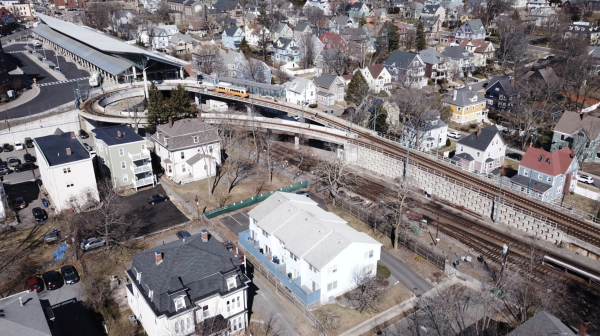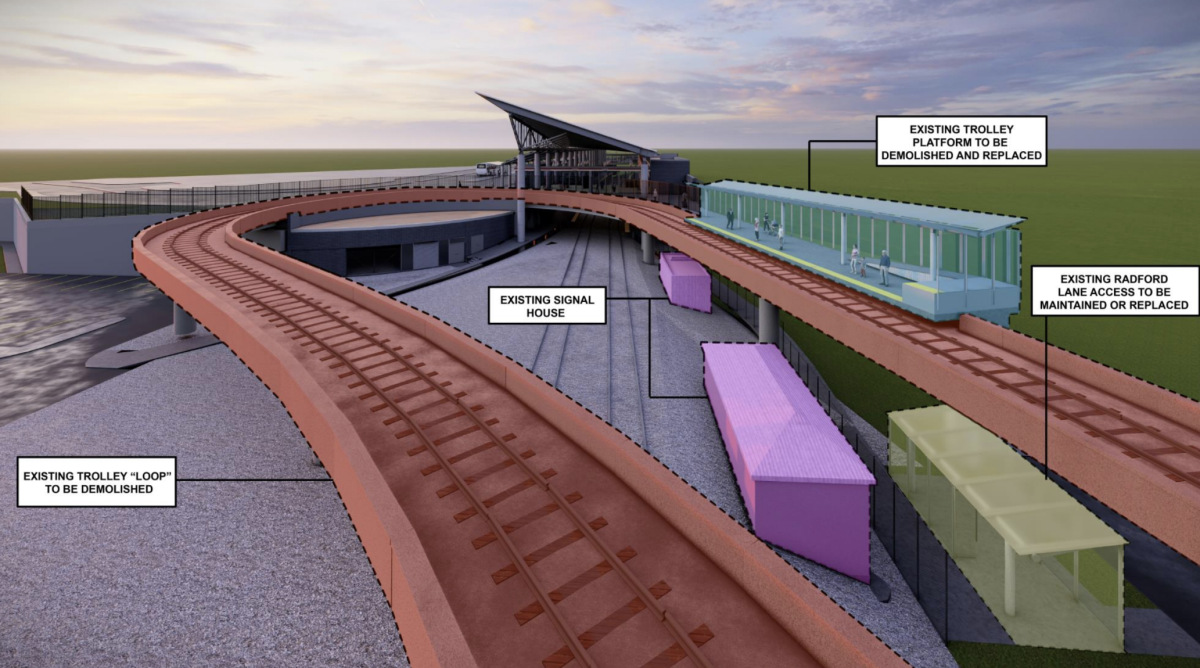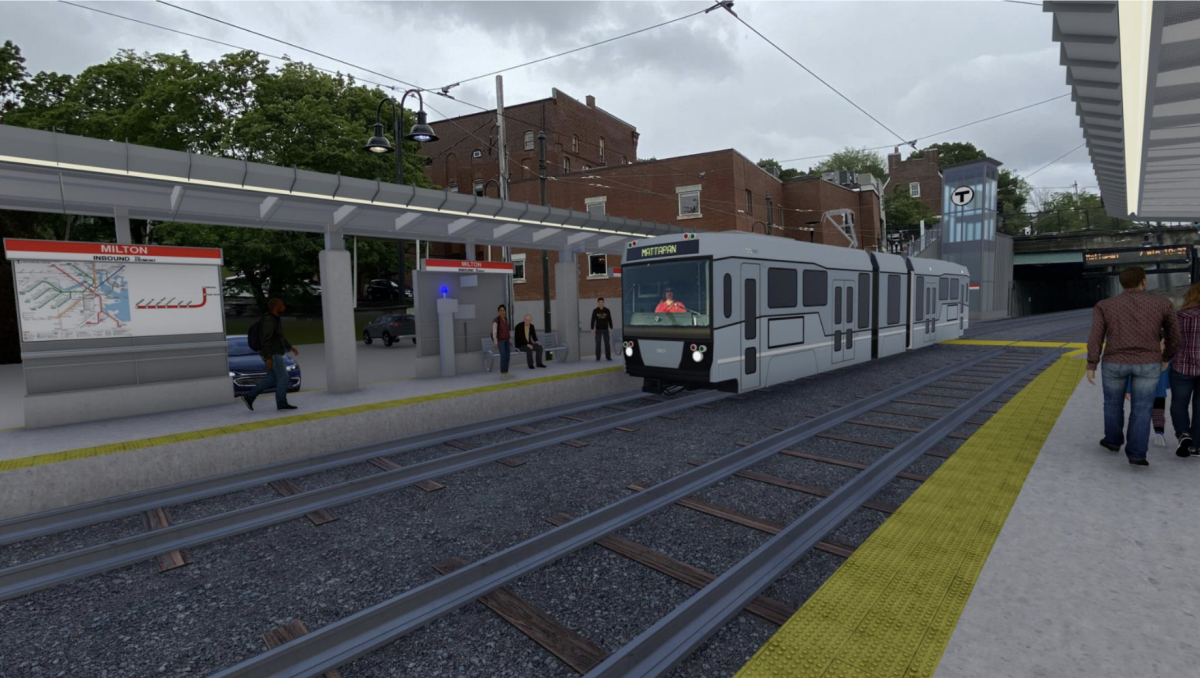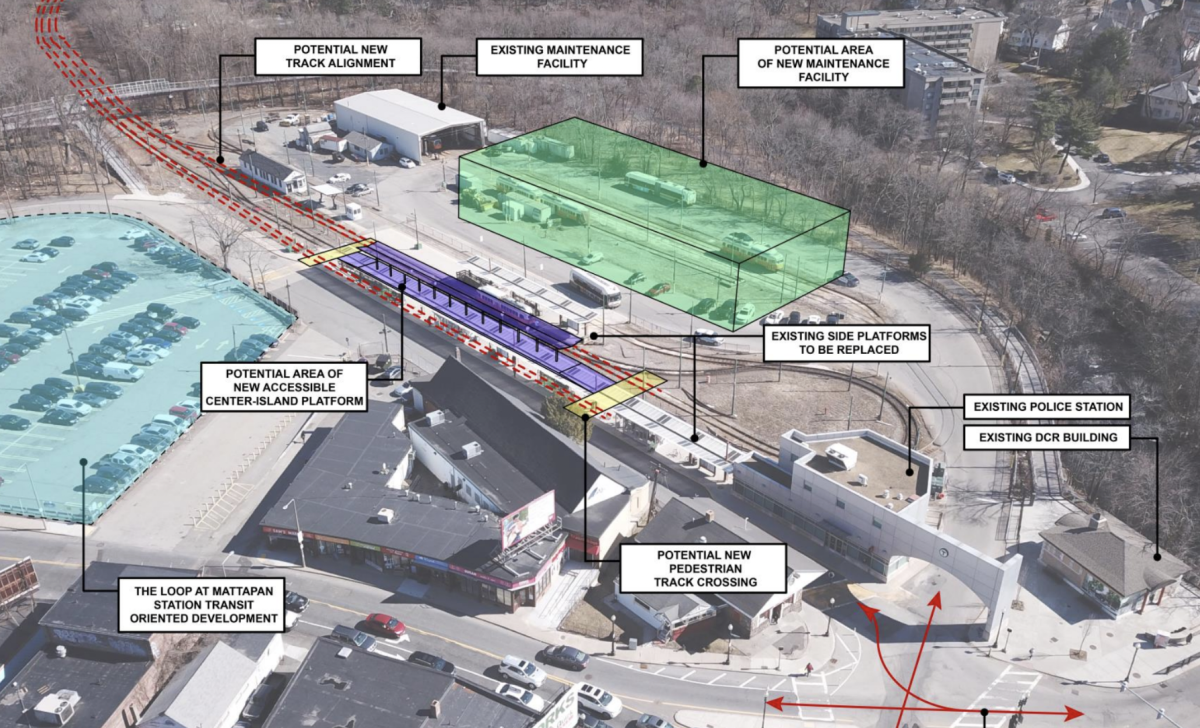June 21, 2023

The Ashmont loop that carries trolleys on the Mattapan line. (Image via MBTA)
A MBTA proposal to overhaul its Mattapan trolley line with new passenger platforms and vehicles could also bring massive changes to Ashmont Station, which serves the Red Line and the trolley line. MBTA officials said Tuesday they’re considering the demolition of the bridge that carries trolleys in and out of Ashmont.
The Mattapan line runs from Ashmont down to Mattapan Square, which is the trolley line’s terminus. The line has stops in Cedar Grove, Lower Mills, and Milton, ferrying passengers in 1940s trolleys.
At a virtual meeting on Tuesday attended by nearly 120 people, MBTA officials and contractors outlined some of the proposed changes to the line, which could take a decade to implement. The planned overhaul is already years behind schedule.
The MBTA has so far committed $127 million to the overhaul, though that is just a preliminary figure. The figure includes refurbishing the current decades-old trolleys to keep them running before they’re phased out for the newer vehicles.
The MBTA is proposing to replace the line’s eight World War II-era trolleys, known as Presidents’ Conference Committee (PCC) cars, with eight “Type 9” vehicles currently running on the Green Line. The “Type 9” trains can carry more passengers and are more dependable in the wintertime than the PCC cars. They are also quieter than the PCC cars, according to the T.
The newer vehicles, which the T plans to refurbish before putting them on the trolley line, mean the Ashmont loop that carries the old trolleys over Red Line tracks to a platform for trolley riders, and then back down again, may no longer be necessary. The at-grade loop at the Mattapan Square station would also be rendered unnecessary, according to T officials.
The existing bridge structure at Ashmont, sometimes referred to as a viaduct, cannot support the “Type 9,” due to the turn radius and length of the vehicles, so it must be torn down, the officials said at the virtual meeting. Additionally, the “Type 9” trains can move in both directions, so they do not need to complete a loop in order to turn around.
The T is weighing two options: Removing the current bridge and rebuilding it at an elevated level, or removing it and putting a new passenger platform for the trolley at ground level with the Red Line trains, meaning passengers can connect to and from the Red Line without going up and down a set of stairs, as they currently do.
At the Mattapan Square terminus for the trolley, the tracks are already at-grade but there is still a significant amount of work, according to T officials. Buses come in, the MBTA Police have a building there, and is the storage and maintenance location of the Mattapan line. The MBTA’s overhaul of the trolley lines calls for a new maintenance facility at the station.
The plans for Ashmont and Mattapan Stations remain under development, due to the complexities involved, more so than the simpler stations between Ashmont and Mattapan Square.
 The MBTA is proposing demolishing the Ashmont loop. (Rendering via MBTA)
The MBTA is proposing demolishing the Ashmont loop. (Rendering via MBTA)
The Tuesday meeting also included renderings of plans for the Milton and Central Avenue stations. At the Milton stop, the inbound and outbound platforms would be kept at the same locations due to the space restrictions in the area. But Milton would see the same improvements as the other stations: Wind screens, seating, an emergency call box and canopies above people’s heads. The other stations are slated to be center-island platforms.
One addition to Milton that the other stations won’t see is an elevator, which would replace the already-demolished stairs from Adams Street. The demolishment of the stairs earlier this year enraged Milton officials, who noted the stairs had been closed for nearly a decade after falling into disrepair.
Aside from the elevator, passengers will also have the option of a sloped walkway from Adams Street, according to AJ Tanner, one of the MBTA officials at the Tuesday meeting.
 A rendering of the Milton stop on the Mattapan line. (Image via MBTA)
A rendering of the Milton stop on the Mattapan line. (Image via MBTA)
State Sen. Walter Timilty, who represents Milton, was also at the meeting, noted that the Mattapan Line overhaul is four to five years behind schedule. He asked when the stairs will be replaced, and Tanner answered that at this time they don’t have dates for the completion of the sloped walkway. Timilty called the answer unacceptable.
T officials also laid out construction cost estimates, which did not include the cost of designing the new stations. The construction cost of re-doing Milton Station comes to $11.5 million, while Valley Road’s overhaul would cost $20.8 million, due its elevation and the extensive work needed to add ramps and re-do walls, ensuring compliance with the Americans with Disabilities Act (ADA).
The construction costs of the other stations are $6.8 million for Cedar Grove Station, $9.5 million for Butler Station, $9.5 million for Central Avenue and $8 million for Capen Street.
MBTA officials provided ridership updates. The trolley line is seeing 3,823 people board at stations on every weekday, down from a pre-pandemic number of 6,580.
Attendees had a range of questions for T officials, with some grumbling about the trolley line receiving refurbished Green Line trolleys instead of brand new vehicles.
When one attendee asked whether the Green Line’s “Type 9s” will be repainted orange, to match the color of the current PCC cars, Tanner said the vehicle color hasn’t been decided yet but the T will consider public input. “We understand it’s important to capture the essence of the historic Mattapan trolley line,” he said.
 The MBTA also plans to overhaul the Mattapan Square station loop. (Image via MBTA)
The MBTA also plans to overhaul the Mattapan Square station loop. (Image via MBTA)


